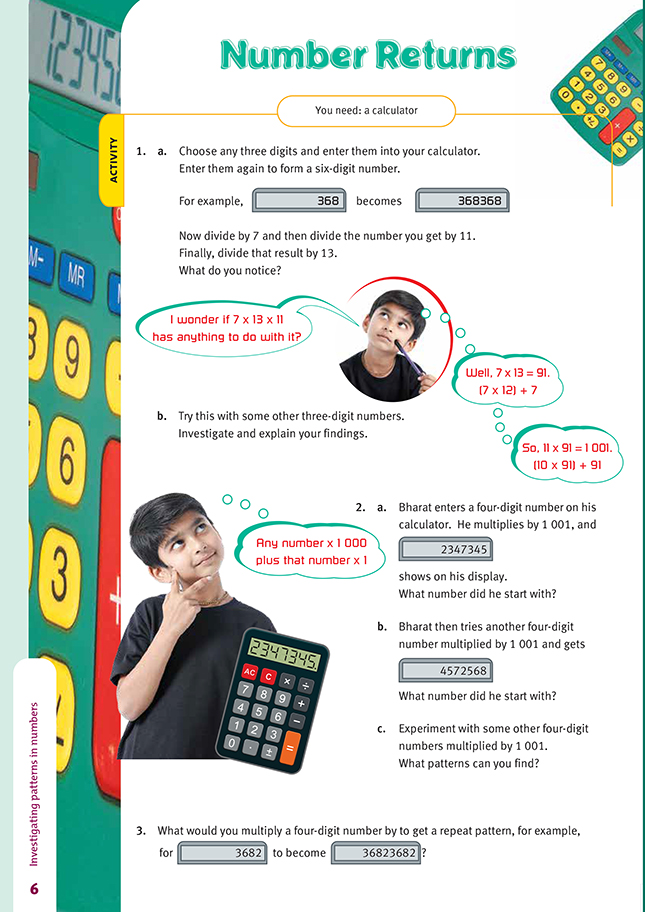This is a level 4 algebra activity from the Figure It Out series.
A PDF of the student activity is included.
Click on the image to enlarge it. Click again to close. Download PDF (221 KB)
investigate patterns when multiplying numbers
FIO, Level 4+, Number, Book Six, Number Returns, page 6
A calculator
In question 1, which involves three-digit numbers, the students will find that they always get their original number, no matter which three numbers they try, after dividing consecutively by 7, 11, and 13. The question, of course, is why this happens. The boy wondering about 7 x 11 x 13 provides a clue. In effect, when dividing
consecutively by 7, 11, and 13, they have been dividing by 1 001. If they try multiplying a three-digit number by 1 001, they may get a better idea of what is happening. For example, 368 x 1 001 effectively gives one lot of 368 and one thousand lots of 368 (368 000). Combined, this gives 368 368, the repeating type of
pattern they have been investigating.
Another way of looking at this is:
368 368
= (300 x 1 000) + (300 x 1) + (60 x 1 000) + (60 x 1) + (8 x 1 000) + 8 x 1)
= (300 + 60 + 8) x 1 000 + (300 + 60 + 8) x 1
= 368 x 1 000 + 368 x 1
= 368 x 1 001
You could challenge your students to consider what they would need to multiply a two-digit number by to achieve a repeating pattern (it turns out to be 101: for example, with 75, it’s one lot of 75 and 100 lots of 75, which altogether is 7 575) and even what they have to multiply a one-digit number by for it to repeat
(multiply by 11).
When the students move on to question 2, they will see that multiplying a four-digit number by 1 001 does not give a product with repeated digits. Encourage them to use logic and reasoning and their knowledge of multiplication and place value, rather than a calculator, to find the numbers that Mike started with. (They could use a calculator to check their reasoning.)
After multiplying by 1 001, Mike has a product of 2 347 345, which is one thousand lots of the four-digit number plus one lot of the four-digit number, that is:
From here, it is relatively straightforward to work out most of the missing digits:
The students can use logic and reasoning to see that the two missing digits that add up to 7 will be 2 and 5, and so the original four-digit number was 2 345.
They can approach question 2b in the same way:
which leads to:
They know from question 2a that the first and last digit add up to the middle digit:
From here, they can use their knowledge of addition to fill in the last gap and find the original four-digit number (4 568).
The students will use the understanding gained in questions 1 and 2 to answer question 3. For the digits
to repeat, without any of them changing by being added, they must have:
So the four-digit number must be multiplied by 10 001.
Answers to Activity
1. a. You get your original three-digit number.
b. You get your original three-digit number because you are dividing by 1 001 (7 x 11 x 13) altogether. When you multiply a three-digit number by 1 001, you get a repeat pattern, for example:
2 . a. 2 345
b. 4 568
c. Descriptions of patterns will vary, but the result is always seven digits. You might notice that the first two digits and the last two digits of the answer are the same as the first two digits and the last two digits of the original number. The middle digits vary according to whether the first and last digits of the original number add up to 10 or more.
3. 10 001







